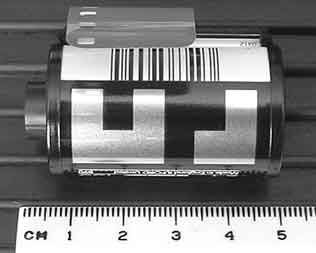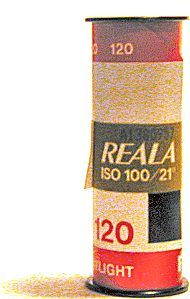Related Research Articles

Film stock is an analog medium that is used for recording motion pictures or animation. It is recorded on by a movie camera, developed, edited, and projected onto a screen using a movie projector. It is a strip or sheet of transparent plastic film base coated on one side with a gelatin emulsion containing microscopically small light-sensitive silver halide crystals. The sizes and other characteristics of the crystals determine the sensitivity, contrast and resolution of the film. The emulsion will gradually darken if left exposed to light, but the process is too slow and incomplete to be of any practical use. Instead, a very short exposure to the image formed by a camera lens is used to produce only a very slight chemical change, proportional to the amount of light absorbed by each crystal. This creates an invisible latent image in the emulsion, which can be chemically developed into a visible photograph. In addition to visible light, all films are sensitive to X-rays and high-energy particles. Most are at least slightly sensitive to invisible ultraviolet (UV) light. Some special-purpose films are sensitive into the infrared (IR) region of the spectrum.

135 film, more popularly referred to as 35 mm film or 35 mm, is a format of photographic film used for still photography. It is a film with a film gauge of 35 mm (1.4 in) loaded into a standardized type of magazine – also referred to as a cassette or cartridge – for use in 135 film cameras. The engineering standard for this film is controlled by ISO 1007 titled '135-size film and magazine'.

DX encoding is an ANSI and I3A standard, originally introduced by Kodak in March 1983, for marking 135 and APS photographic film and film cartridges. It consists of several parts, a latent image DX film edge barcode on the film below the sprocket holes, a code on the cartridge used by automatic cameras, and a barcode on the cartridge read by photo-finishing machines.

Single-8 is a motion picture film format introduced by Fujifilm of Japan in 1965 as an alternative to the Kodak Super 8 format. The company Konan claims in its history page to have developed the Single-8 system in 1959.

Roll film or rollfilm is any type of spool-wound photographic film protected from white light exposure by a paper backing. The term originated in contrast to sheet film. Confusingly, roll film was originally often referred to as "cartridge" film because of its resemblance to a shotgun cartridge.

FUJIFILM Holdings Corporation, trading as Fujifilm, or simply Fuji, is a Japanese multinational conglomerate headquartered in Tokyo, Japan, operating in the realms of photography, optics, office and medical electronics, biotechnology, and chemicals.

Velvia is a brand of daylight-balanced color reversal film produced by the Japanese company Fujifilm. The name is a portmanteau of "Velvet Media", a reference to its smooth image structure. The original incarnation of the film was called "Velvia for Professionals", known as RVP, a classification code meaning "Reversal/Velvia/Professional series". It is known for its extremely high level of color saturation and image quality.

Instant film is a type of photographic film that was introduced by Polaroid Corporation to produce a visible image within minutes or seconds of the photograph's exposure. The film contains the chemicals needed for developing and fixing the photograph, and the camera exposes and initiates the developing process after a photo has been taken.

Provia is a brandname for a pair of daylight-balanced color reversal films produced by the Japanese film company Fujifilm. It is currently available in one speed, 100/21°, marketed as Fujichrome Provia 100F Professional [RDP III],. An additional speed of 400/27°, marketed as Fujichrome Provia 400X Professional [RXP], was previously available.
Polaroid Type 55 film is a black-and-white peel-apart Polaroid film that yields both a positive print and a negative image that can be used to create enlargements.

Analog photography, known as film photography, is an incorrect term for photography that uses chemical processes to capture an image, typically on paper, film or a hard plate. Analog is a word used to define what a video signal was before digital came along. These photographic processes were the only methods available to photographers for more than a century prior to the invention of digital photography, which uses electronic sensors to record images to digital media.

Fujicolor Superia is a Fujifilm brand of daylight balanced colour negative film introduced ca.1998 primarily aimed at the consumer market, but was also sold in a professional 'press' variant. A key feature at launch was the '4th' cyan colour layer designed to provide improved colour reproduction under fluorescent lighting. Its Kodak equivalent is the Kodacolor Gold/Ultramax line.

Tri-X is a black and white photographic film produced by the Eastman Kodak Company. Since 2013 it is distributed by Kodak Alaris which controls the Kodak Professional product line under which it is grouped. The combination of hand held cameras and high speed Tri-X film was transformative for photojournalism and for cinema.

Kodak Portra is a family of daylight-balanced professional color negative films originally introduced in 1998 made mainly for portrait and wedding applications. They are successors of the professional Vericolor films, which succeeded Ektacolor films earlier. The films are available in three speeds — 160, 400, and 800 ISO — with the 160 and 400 speed formerly available as "natural color" (NC) and "vivid color" (VC) varieties before the 2011 update.

Photographic film is a strip or sheet of transparent film base coated on one side with a gelatin emulsion containing microscopically small light-sensitive silver halide crystals. The sizes and other characteristics of the crystals determine the sensitivity, contrast, and resolution of the film.

Neopan was originally a family of black-and-white films from Japanese manufacturer Fujifilm for both professional and amateur use. The range now only comprises one film; Neopan ACROS 100 II, a traditional silver halide black and white film re-launched in 2019 and currently sold worldwide.

Cinestill Film is a Los Angeles based selling film for analog cameras from repacked or respooled Kodak motion picture cinema film stock. The two brothers who founded the company started with hacking cameras and lenses, then moved on to selling film.
References
- ↑ "Fujicolor Pro 160S and Pro 160C now available".
- ↑ "Fujicolor Pro Negative Family Brochure" (PDF). Fujifilm . Retrieved 2008-11-30.
- ↑ "Fujifilm to Discontinue Fujicolor Pro 800Z | Photography Blog".
- 1 2 "フジカラー PRO 160NS プロフェッショナル 120サイズ フジクローム VELVIA50 CUTサイズ 販売終了のご案内 | 富士フイルムイメージングシステムズ株式会社". www.fujifilm.com (in Japanese). Retrieved 2021-10-15.
- ↑ "Fujifilm Retires Three Films | Photography Blog".
- ↑ "Exclusive: Fujifilm Announces End of Pro NS 160 Sheet Film". 29 July 2016.
- ↑ "Fujifilm Announces Discontinuation of Fujicolor Pro 160 · Lomography". www.lomography.com. Archived from the original on 2018-01-22.
- ↑ "Fuji Pro 160NS 120 5 Pack".
- ↑ "Fuji PRO 160 NS roll film 120 pack of five | Color negative films | Film | macodirect EN". www.macodirect.de. Archived from the original on 2018-11-27.
- ↑ "FUJI PRO 160 NS Negativ-Farbfilm, 120 Rollfilm 5 Stück **02/2019 Garantie-ffilm484". www.nordfoto.de. Archived from the original on 2018-11-27.
- ↑ "Fuji NPH 400 ProfessionalFuji ReInvents Fast Color Negative Film". November 2002.
- ↑ "富士フイルムイメージングシステムズ株式会社".
- ↑ "Fujicolor PRO400H Professional Discontinuation Notice" . Retrieved 2021-01-16.
- ↑ "Important Information Regarding Discontinuation of PRO 400H Film" (PDF). Retrieved 2021-01-16.
- ↑ "フジカラー PRO400H プロフェッショナル 出荷終了時期変更のお知らせ" . Retrieved 2021-05-31.